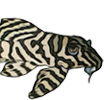Biotope tanks are an almost impossible concept anyways, unless you can actually go catch your fish yourself. The fish caught for our hobby are almost all coming from different habitats, even if they originate from the same river. Most of the fish we put together in a tank "will never meet in nature" - what I mean by that, is that they aren't from the same little square meter of river. Some like to live in planted sections along the slower sections, others live in fast-flowing rock-riffles, others in the deeper sections in the middle of the river, etc. Bear in mind also that if it says that, say, Green Neon tetra comes has a distrubution of
Orinoco or
Negro, the fish don't actually live in Rio Orinoco or Rio Negro as such. In this particular case, they are from slow-flowing black-water rivers in (flooded) forest. The same principle of "naming the large river that the small drainages flow into" applies to many of the fish we find in the trade. Most of the smaller fish that are suitable to keep in an aquarium aren't "big river" fish. Obviously, the larger the fish, the bigger the body of water, as a general rule. Small fish may also live near the edges of large bodies of water.
Sure, you can find, if you really do know what you are looking for, some fish that are likely to "meet" (and not in the context of one being food and the other the feeder!). But it's hard work.
I prefer to look at it from a habitat/water chemistry point of view - what areas do the fish live in when they are found in the wild? Shallow, fast-flowing rocky rivers, slow-moving planted sections, drift-wood snags, or something like that... Then find fish that are happy to live in that habitat. Of course, you can have a bit of a mix, some rocky bits with good flow in one section, and a bit less movement and some plants on the other end of the tank, or some such. In this view, it's possible to keep fish from different geographical regions...
--
Mats







